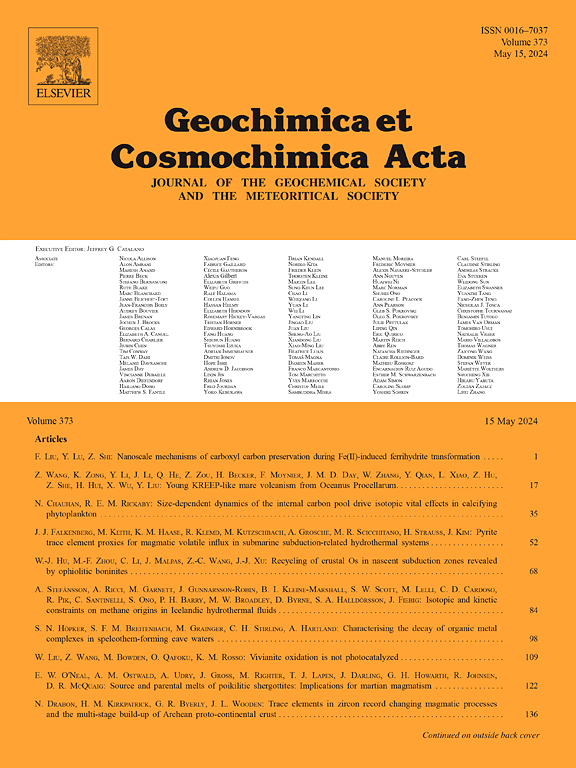Equilibrium indium isotope fractionation in chloride-rich aqueous solutions using first-principles calculations
IF 4.5
1区 地球科学
Q1 GEOCHEMISTRY & GEOPHYSICS
引用次数: 0
Abstract
Aqueous indium (In) speciation and isotope fractionation factors are important to understand the origin and transport of indium during magmatic-hydrothermal and atmosphere-hydrosphere processes. Here, we investigate indium speciation in chloride-rich aqueous solutions and explore their reduced partition function ratios (103lnβ) using first-principles calculations. The simulations with initial configurations of InCl(H2O)52+, InCl2(H2O)4+, InCl3(H2O)3, InCl4(H2O)2− and InCl5(H2O)2− were performed at 400 and 600 K, respectively. The results show that InCl(H2O)52+, InCl2(H2O)4+, InCl3(H2O)2.4, InCl4− and InCl52− are the stable In3+ species at 400 K, and their 103lnβ decreases from 1.00 ‰, 0.89 ‰, 0.83 ‰, 0.75 ‰ to 0.66 ‰. At 600 K, the stable In3+ species are composed of InCl(H2O)52+, InCl2(H2O)3.7+, InCl3(H2O)1.7, InCl4− and InCl52− with their 103lnβ decreasing from 0.46 ‰, 0.42 ‰, 0.39 ‰, 0.35 ‰ to 0.31 ‰. These results indicate that 103lnβ is negatively correlated with the coordination number and bond length of chlorine ligands in aqueous In3+ species. Meanwhile, water molecules are gradually removed from the first hydration shell gradually with increasing temperature, such as InCl2(H2O)4+ and InCl4(H2O)2− to InCl2(H2O)3.7+ and InCl4−, indicating that stable In3+ species changes with temperature. Hence, estimating the 103lnβ of aqueous liquids at different temperatures should consider the potential structure transition of cation species. The calculations of equilibrium indium isotope fractionation factors provide important insights into the mechanism of isotope fractionation in aqueous liquids, and show the potential application of indium isotopes in the geological and supergene processes of indium.
用第一性原理计算富氯化物水溶液中平衡铟同位素分馏
水相铟(In)形态和同位素分馏因子对于理解岩浆-热液和大气-水圈过程中铟的起源和输运具有重要意义。在这里,我们研究了铟在富氯化物水溶液中的形态,并利用第一性原理计算探索了它们的减少配分函数比(103lnβ)。分别在400 K和600 K下进行了初始配置为InCl(H2O)52+、InCl2(H2O)4+、InCl3(H2O)3、InCl4(H2O)2−和InCl5(H2O)2−的模拟。结果表明:在400 K时,InCl(H2O)52+、InCl2(H2O)4+、InCl3(H2O)2.4、InCl4−和InCl52−是稳定的In3+组分,它们的103lnβ从1.00‰、0.89‰、0.83‰、0.75‰下降到0.66‰;在600 K时,稳定的In3+由InCl(H2O)52+、InCl2(H2O)3.7+、InCl3(H2O)1.7、InCl4−和InCl52−组成,它们的103lnβ从0.46‰、0.42‰、0.39‰、0.35‰下降到0.31‰。结果表明,在水溶液中,103lnβ与氯配体的配位数和键长呈负相关。同时,随着温度的升高,水分子逐渐从第一水化壳层中移除,如InCl2(H2O)4+和InCl4(H2O)2−到InCl2(H2O)3.7+和InCl4−,表明稳定的In3+物质随温度的变化而变化。因此,估算不同温度下水溶液的103lnβ时,应考虑阳离子种类的潜在结构转变。平衡铟同位素分馏因子的计算为研究水相液体中铟同位素分馏机理提供了重要的思路,并显示了铟同位素在铟地质和表生过程中的潜在应用。
本文章由计算机程序翻译,如有差异,请以英文原文为准。
求助全文
约1分钟内获得全文
求助全文
来源期刊

Geochimica et Cosmochimica Acta
地学-地球化学与地球物理
CiteScore
9.60
自引率
14.00%
发文量
437
审稿时长
6 months
期刊介绍:
Geochimica et Cosmochimica Acta publishes research papers in a wide range of subjects in terrestrial geochemistry, meteoritics, and planetary geochemistry. The scope of the journal includes:
1). Physical chemistry of gases, aqueous solutions, glasses, and crystalline solids
2). Igneous and metamorphic petrology
3). Chemical processes in the atmosphere, hydrosphere, biosphere, and lithosphere of the Earth
4). Organic geochemistry
5). Isotope geochemistry
6). Meteoritics and meteorite impacts
7). Lunar science; and
8). Planetary geochemistry.
 求助内容:
求助内容: 应助结果提醒方式:
应助结果提醒方式:


